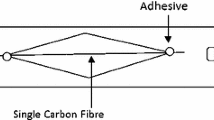Abstract
The failure properties of flax fibres were investigated using a tow behaviour-based approach that was developed on ceramic and glass fibres. The Weibull and normal strength distributions of filament failure strains and the true statistical parameters were extracted from the tensile curve of a tow test specimen made of several 100 of filaments. Tensile tests were carried out on flax tows possessing more than 1000 continuous elementary fibres. The force–strain curves were found to follow the theory of bundles of independent and parallel continuous filaments. Weibull and normal distributions of filaments failure strains were reproducible and in excellent agreement. The results of the present work are compared to strengths of elementary and technical fibres reported in the literature. The dependence of statistical parameters on factors including sample size and selection, and method of experimental data analysis was investigated. For this purpose, subsets of failure strains were analysed, and the normal distribution-based approach was applied to sets of failure strain data of elementary fibres reported in the literature. Finally, the flax fibre was compared to E glass fibre using statistical distributions of failure strengths.















Similar content being viewed by others
References
Joshi S, Drzal L, Mohanty A, Arora S (2004) Are natural fibre composites environmentally superior to glass fibre reinforced composites? Compos Part A 35:371–376
Le Duigou A, Davies P, Baley C, Biobased J (2011) Environmental impact analysis of the production of flax fibres to be used as material reinforcement. Mater Bioenergy 5:153–165
Baley C (2002) Analysis of the flax fibres tensile behaviour and analysis of the tensile stiffness increase. Compos Part A 33:939–948
Martin N, Davies P, Baley C (2014) Comparison of the properties of scotched flax and flax tow for composite material reinforcement. Ind Crops Prod 61:284–292
Lefeuvre A, Bourmaud A, Morvan C, Baley C (2014) Tensile properties of elementary fibres of flax and glass: analysis of reproducibility and scattering. Mater Lett 130:289–291
Moothoo J, Allaoui S, Ouagne P, Soulat D (2014) A study of the tensile behaviour of flax tows and their potential for composite processing. Mater Des 55:764–772
Barbulée A, Jernot J-P, Bréard J, Gomina M (2014) Damage to flax fibre slivers under monotonic uniaxial tensile loading. Compos Part A 64:107–114
Charlet K, Baley C, Morvan C, Jernot JP, Gomina M, Bréard J (2007) Characteristics of Hermès flax fibres as a function of their location in the stem and properties of the derived unidirectional composites. Compos Part A 38:1912–1921
Davies GC, Bruce DM (1998) Effect of environmental relative humidity and damage on the tensile properties of flax and nettle fibres. Text Res J 68:623–629
Bos HL, Van den Oever MJA, Peters OCJJ (2002) Tensile and compressive properties of flax fibres for natural fibre reinforced composites. J Mater Sci 37:1683–1692
Andersons J, Sparnins E, Joffe R, Wallstrom L (2005) Strength distribution of elementary flax fibres. Compos Sci Technol 65:693–702
I Van de Weyenberg, J Ivens, I Verpoest (2000) Parametric study of the relationship between the fibre and the composite properties of flax fibre reinforced epoxy. In: Proceedings of ECCM9, Brighton
Joffe R, Andersons J, Wallstrom L (2003) Strength and adhesion characteristics of elementary flax fibres with different surface treatments. Compos Part A 34:603–612
Romhany G, Karger-Kocsis J, Czigany T (2003) Tensile fracture and failure behaviour of technical flax fibres. J Appl Polym Sci 90:3638–3645
R’Mili M, Godin N, Lamon J (2012) Flaw strength distributions and statistical parameters for ceramic fibres: the Normal distribution. Phys Rev E 85:1106–1112
R’Mili M, Murat M (1989) Caractérisation des fibres par amélioration de l’essai sur mèche avec mesure directe de la déformation. C R Acad Sci B Phys 324:355–364
Calard V, Lamon J (2004) Failure of fibres bundles. Compos Sci Technol 64:701–710
R’Mili M, Bouchaour T, Merle P (1996) Estimation of Weibull parameters from loose bundle tests. Compos Sci Technol 56:831–834
Determination of distribution of tensile strengths and of tensile strains to failure of filaments within a multifilament tow at ambient temperature. European standard EN 1007-5. Advanced technical ceramics—Ceramic composites—Methods of test for reinforcements-Part 5 1998
Coleman BD (1958) On the strength of classical fibres and fibres bundle. J Mech Phys Solid 7:60–70
Daniels HE (1945) The statistical theory of the strength of bundles of threads I. Proc R Soc A183:405–435
Thomason JL, Carruthers J, Kelly J, Johnson G (1996) Fibre cross-section determination and variability in sisal and flax and its effects on fibre performance characterization. Comp Sci Technol 56:831–834
C. Renard (2015) Private communication
Renard C, Thibault JF (1996) Pectins in mild alkaline conditions: b elimination and kinetics of demethylation. In: Visser J, Voragen AGJ (eds) Pectins and Pectinases. Elsevier, Amsterdam, pp 603–608
Bergman B (1984) On the estimation of the Weibull modulus. J Mater Sci Lett 3:689–692
Davies IJ (2004) Best estimate of Weibull modulus obtained using linear least squares analysis: an improved empirical correction factor. J Mater Sci 39:1441–1444
Griggs JA, Zhang Yunlong (2003) Determining the confidence intervals of Weibull parameters estimated using a more precise probability estimator. J Mater Sci Lett 22:1771–1773
Lamon J (2016) Brittle fracture and damage of brittle materials and composites: statistical probabilistic approaches. ISTE Press Ltd, Elsevier Ltd, London
Acknowledgements
The authors would like to thank Dr. M. Gomina for supplying flax fibre.
Author information
Authors and Affiliations
Corresponding author
Rights and permissions
About this article
Cite this article
Lamon, J., R’Mili, M. & Reveron, H. Investigation of statistical distributions of fracture strengths for flax fibre using the tow-based approach. J Mater Sci 51, 8687–8698 (2016). https://doi.org/10.1007/s10853-016-0128-9
Received:
Accepted:
Published:
Issue Date:
DOI: https://doi.org/10.1007/s10853-016-0128-9




